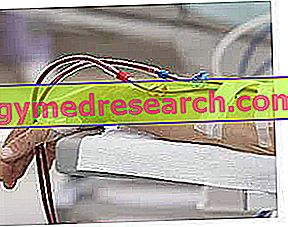Generality
The saphenous vein is the large subcutaneous venous vessel which, starting from the foot, runs along the entire lower limb, up to the groin area.

Representing the longest vein of the human body, the saphenous vein flows, during its groin path, near the medial malleolus, along the medial portion of the leg, behind the knee and along the anterior aspect of the thigh.
When climbing from the foot to the groin, the saphenous vein receives blood from numerous tributary veins.
The confluence in the common femoral vein indicates the conclusion of the course of the saphenous vein along the lower limb.
The saphenous vein is important both in the pathological and clinical therapeutic ambit.
What is the Vena Safena?
The saphenous vein, or great saphenous vein, is the large subcutaneous (therefore superficial) venous vessel that covers the entire lower limb, from the foot to the groin.
Equal anatomical element (ie present both in the right lower limb and in the left lower limb), the saphenous vein holds the primacy of " the longest vein in the human body ".
Is "saphenous vein" or "great saphenous vein" more correct?
Among the terms "saphenous vein" and "great saphenous vein", the most precise and correct is the second, even if the former is not only universally accepted but also the most employed.
The adjective "large" would serve to avoid any confusion with the other veins of the lower limb, whose anatomical name includes the word "saphenous" (small saphenous vein and accessory saphenous vein).
Origin of the name
The origin of the name "vena sapena" is uncertain. According to some, in fact, the term "saphenous" derives from the ancient Greek word " safaina ", whose meaning is "easily visible"; according to someone else, instead, it would derive from the Arabic word " safin ", which means "hidden".
Anatomy
Introduction: in anatomy, the description of the course of veins and arteries, in the human body, is based on the direction of blood flow; in practical terms, this means that the description of the path of a vein will start from the periphery (venous blood runs from the periphery to the heart), while the description of the path of an artery will start from the end closest to the heart (arterial blood flows from the heart to the periphery).
The saphenous vein begins in that region of the foot, in which the so-called dorsal vein of the big toe merges into the so-called dorsal venous arch of the foot (or venous arch of the foot ).
The dorsal venous arch of the foot lies at the height of the distal portion of the metatarsals ; the metatarsals are the bones of the foot located between the tarsus bone group (proximal skeletal portion of the foot) and the phalanges (distal skeletal portion of the foot).
From here, it continues in the direction of the medial malleolus (or internal malleolus ) and, shortly before reaching the latter (thus staying in front), turns towards the leg, moving towards the groin.
In normal-weight or non-obese people, the portion of the saphenous vein that passes in front of the internal malleolus is visible and even palpable.
Along the leg, the saphenous vein remains in the medial position (therefore, it flows inside the leg), up to the knee . At knee height, it moves slightly behind it, passing precisely behind the medial epicondyle of the femur (or internal epicondyle of the femur ).
The medial epicondyle of the femur is the particular bony eminence placed above the so-called medial condyle of the femur, which, together with the lateral condyle of the femur, participates in the knee joint.
Once past the knee, the saphenous vein takes on an orientation that leads it to pass more and more on the front face of the thigh; here - that is on the thigh - it ends its path when it is about 3-4 centimeters from the so-called pubic tubercle (see pubis ).
To mark the conclusion of the path of the saphenous vein, is its confluence in the common femoral vein, at the height of the so-called femoral triangle (or Scarpa's triangle ).
The confluence point of the saphenous vein in the femoral vein is called the sapheno-femoral junction .
Between the fascia lata (anteriorly) and the pectineus muscles, long adductor and ileopsoas, the femoral triangle is the particular anatomical hollow space of the thigh, which houses the femoral artery, the femoral vein, the femoral nerve and the femoral sheath, inguinal lymphatic vessels and deep inguinal lymph nodes .
Where it joins the common femoral vein, the saphenous vein forms a characteristic arch, called the saphenous arch, and passes through an opening on the fascia lata, called the saphenous opening or oval fossa .
Other anatomical features of the saphenous vein
- During its journey along the leg, first, and along the thigh, then, the saphenous vein is included in an anatomical space called the saphenous compartment . The saphenous compartment has, as a posterior limit, the so - called crural fascia (in the leg) and the aforementioned fascia lata (in the thigh), and, as an anterior (or superficial) limit, the so - called saphenous fascia .
- For its entire course along the lower limb, the saphenous vein is equipped with valves that prevent the blood from turning back. In other words, it is provided with special elements that push the blood in a single direction (which, as with any vein, is from the periphery towards the heart).
In general, the valves in question are between 10 and 20 units .

- Of the 10-20 valves that run through the saphenous vein, one is almost always (in 99 cases out of 100) located 1-3 mm from the sapheno-femoral junction.
- Only in the section below the knee, the saphenous vein borders, anteriorly and posteriorly, with the branches of the so-called saphenous nerve .
Tributaries of the saphenous vein
Premise: in anatomy, the veins that converge in another venous vessel, generally more important, take the name of tributary veins.
The most important tributary veins of the saphenous vein are:
- In the foot, the medial marginal vein .
- In the leg, the small saphenous vein, the perforating veins of the anterior and posterior tibial veins (Cockett's perforating veins) and the cutaneous veins present in this anatomical region.
- At knee height, the perforating vein of the popliteal vein (Boyd's perforating vein)
- In the thigh, the perforating veins of the deep femoral vein (Dodd veins), the accessory saphenous vein, the superficial epigastric vein, the superficial iliac circumflex vein and the superficial external pudenda vein .
What are perforating veins?
In anatomy, the perforating veins are the venous vessels that connect the superficial venous vessels with the deep ones, crossing the deep muscular bands.
Function
The saphenous vein has the task of collecting venous blood flowing in the foot, ankle, leg, knee and thigh, and discharge it into the common femoral vein. From the common femoral vein, therefore, this blood will continue in the direction of the external iliac vein.
diseases
In the pathological field, the saphenous vein is the protagonist of two medical conditions, both quite frequent and - but only if they are isolated - not dangerous for the life of those affected; the conditions in question are: the so-called varicose veins and thrombophlebitis .
Varicose veins and saphenous vein
Varicose veins (or varices ) are abnormal and saccular dilations of the venous vessels, related to a phenomenon of venous blood stagnation (venous stasis ).
The saphenous vein, like all other superficial venous vessels of the lower limb, is one of the most common sites of varicose veins.

CAUSES
Experts believe, with a certain degree of security, that varicose veins are caused along the venous vessels such as the saphenous vein by a dysfunction of the valve system designed to ensure the flow of blood in the direction of the heart (remember that, for the saphenous vein, this valve system comprises between 10 and 20 elements). The dysfunction of these valves, in fact, would allow the blood to turn back, stagnating in the venous vessels affected (it is the aforementioned stagnation phenomenon) and giving rise to the saccular dilatations typically observed on the occasion of varicose veins.
Risk factors of varicose veins along the saphenous vein: Constipation Obesity Long standing station, kept in a warm environment Congenital alterations of the veins Age between 30 and 50 years Female sex |
SYMPTOMS AND DIAGNOSIS
Varicose veins in vein vessels such as the saphenous vein can cause symptoms and signs, such as:
- Sensations of heavy legs;
- Pain and cramps in the lower limbs;
- Appearance of very visible swollen veins;
- Increased temperature where the problem of varicose veins lies;
- Telangiectasia near where the problem of varicose veins is located;
- Swollen ankles and / or feet;
- Redness, itching and dry skin along the lower leg or at the ankle level (these are three problems associated with so-called stasis dermatitis).
The diagnosis of varicose veins, especially in venous vessels as important as the saphenous vein, is simple and fast; in fact, it requires only the physical examination and the patient's account of the symptoms.
THERAPY
Among the treatments for varicose veins against a venous vessel such as the saphenous vein, there are:
- Conservative remedies, such as elastocompression therapy (based on the use of elastic stockings) and drug therapy (based on the use of phlebotonic, anti-edema, profibrinolytic and anti-inflammatory substances);
- Minimally invasive therapies, such as sclerotherapy and endovascular laser or radiofrequency therapies;
- Invasive therapies, such as surgical therapy aimed at removing a portion of the venous vessel.

Thrombophlebitis and saphenous vein
Thrombophlebitis is the inflammation of the wall of a vein in the upper or lower limbs, due to the formation, in the same vein victim of the inflammatory process, of an abnormal blood clot (whose specific name is thrombus ).
Thrombophlebitis affecting the saphenous vein is an example of superficial thrombophlebitis, as it involves a superficial venous vessel.
CAUSES
The causes of thrombophlebitis in a venous vessel such as the saphenous vein include:
- Diseases and disorders of blood clotting;
- Pregnancy;
- Varicose veins;
- The reduction of blood flow along the venous system;
- Injuries to the walls of the affected venous vessel (in this case, the lesions may be of traumatic or infectious origin or may be due to the improper use of catheters);
- The use of anticancer drugs or contraceptives.
SYMPTOMS
When affecting a venous vessel such as the saphenous vein, thrombophlebitis is responsible, at the site of the inflammation, for symptoms such as: pain, stiffness, swelling, edema and skin redness. Moreover, always when it concerns a vascular element such as the saphenous vein, it can lead to a complication - the so-called deep vein thrombosis - worthy of immediate treatment, due to the possible serious consequences to which it may give rise.
DIAGNOSIS
To formulate a vein thrombophlebitis diagnosis such as the saphenous vein, the information from the patient's medical history, physical examination and symptom report is sufficient.
THERAPY
Among the treatments indicated in the case of thrombophlebitis of the saphenous vein, there are:
- Local use of hesperidin-based ointments, ruscogenin or rutin;
- The use of elastic stockings;
- Intake of non-steroidal anti-inflammatory drugs (NSAIDs);
- The intake of an anticoagulant such as heparin or warfarin;
- The use of thrombolytic drugs, at the onset of a complication such as deep vein thrombosis.
Clinical Use
The saphenous vein also plays a significant role in the clinical and therapeutic field; in fact, the saphenous vein can be used both in the field of so-called cardiovascular surgery and in the field of so-called emergency medicine .
Use in cardiovascular surgery
In the field of cardiovascular surgery, the saphenous vein represents a possible resource of vascular sections (called vascular grafts) to be used as autografts, during aorto-coronary bypass operations .

Obviously, such use of the saphenous vein requires the execution of a surgical operation at the level of the lower limb, aimed at the removal of a tract of the vein in question (obviously, at the end of the collection, restoration of the vascular continuity along the 'lower limb).
If healthy (so if you do not suffer from varicose veins or other diseases), the saphenous vein provides vascular grafts much more appreciated by doctors than synthetic vascular grafts.
Conditions that, in a context of aorto-coronary bypass, require the removal of a vascular graft from the saphenous vein:
- Absence of valid arterial vascular grafts;
- Need to insert more grafts during the same aorto-coronary bypass operation.
Use in emergency medicine
In the field of emergency medicine, the saphenous vein represents an injection site for resuscitation alternatives to standard sites, when these standard sites are unusable due to venous collapse.



